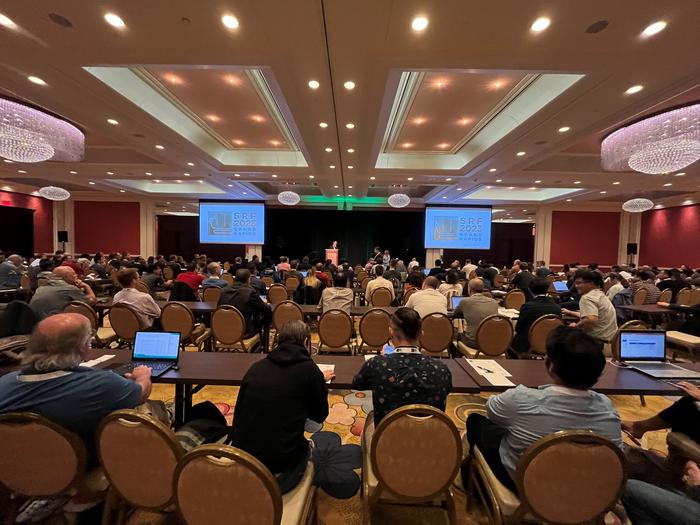GRAND RAPIDS, Mich. – Hundreds of scientific and technical leaders in the superconducting radio frequency (SRF) field converged in Michigan for the 21st International Conference on Radio-Frequency Superconductivity (SRF 2023). The Facility for Rare Isotope Beams (FRIB) served as host for the premier conference 25-30 June in Grand Rapids.

Credit: Facility for Rare Isotope Beams
GRAND RAPIDS, Mich. – Hundreds of scientific and technical leaders in the superconducting radio frequency (SRF) field converged in Michigan for the 21st International Conference on Radio-Frequency Superconductivity (SRF 2023). The Facility for Rare Isotope Beams (FRIB) served as host for the premier conference 25-30 June in Grand Rapids.
The SRF conference is held every two years, rotating between North America, Asia, and Europe. In 2019, the international organizing committee chose FRIB to host the next conference. FRIB was selected as a first-time host due to its success in assembling and building—with the SRF community’s support and curation—what is designed to be the most powerful heavy-ion accelerator. Considering limitations the pandemic posed, FRIB proposed to hold the 2021 meeting virtually and postpone the in-person event to 2023.
Nearly 300 attendees participated in the conference, representing 34 countries and 80 institutions.
The conference included one keynote and three special talks, 66 oral presentations, 321 poster presentations, and 154 papers.
The 2023 conference marks more than 60 years of SRF research and development. SRF technology is a part of many accelerator projects for nuclear physics, particle physics, synchrotron light sources, and free-electron lasers. The SRF conference is organized by an international group of experts, who meet at a host location to discuss the latest advances in the field.
At the conference, scientists, engineers, students, and industrial partners both domestic and international presented and discussed the latest developments in SRF science, technology, and applications. The program included invited talks, poster sessions, a keynote talk, and a tour of FRIB. The conference also provided opportunities for students and early-career researchers to present their work.
Leaders in the SRF community from national and international facilities were well represented in the conference program, including the Institute for Rare Isotope Science, South Korea; the European Spallation Source, Sweden; the European Organization for Nuclear Research (CERN), Switzerland; Shanghai Advanced Research Institute, Chinese Academy of Sciences (SARI-CAS), China; Oak Ridge National Laboratory; RIKEN, Japan; the High Energy Accelerator Research Organization (KEK), Japan; the German Electron Synchrotron (DESY), Germany; TRIUMF, Canada; Brookhaven National Laboratory; Fermi National Accelerator Laboratory; SLAC National Accelerator Laboratory; Thomas Jefferson National Accelerator Facility; and many universities.
The international SRF community helped develop the technology that is key to operating FRIB’s high-power linear accelerator (linac). FRIB’s linac consists of 46 cryomodules of six different types. The cryomodules contain SRF resonators and superconducting solenoid magnets. Operating at cryogenic temperatures of 2 kelvin (K) and 4.5 K, the SRF resonators accelerate the beam with high voltage (> 1 million volts) while the solenoids steer and focus it to hit a target, producing rare isotopes.
In his welcome address at SRF 2023, FRIB Laboratory Director Thomas Glasmacher thanked the SRF community for its profound impact on establishing and now operating FRIB.
“At the heart of FRIB is SRF technology developed and curated by this community,” he said. “Without the SRF community, there would be no FRIB. Thank you very much for welcoming us, teaching us SRF technology, and for allowing us to host this conference.”
Michigan State University (MSU) operates the Facility for Rare Isotope Beams (FRIB) as a user facility for the U.S. Department of Energy Office of Science (DOE-SC), supporting the mission of the DOE-SC Office of Nuclear Physics. User facility operation is supported by the DOE-SC Office of Nuclear Physics as one of 28 DOE-SC user facilities.
The U.S. Department of Energy Office of Science is the single largest supporter of basic research in the physical sciences in the United States and is working to address some of today’s most pressing challenges. For more information, visit energy.gov/science.




